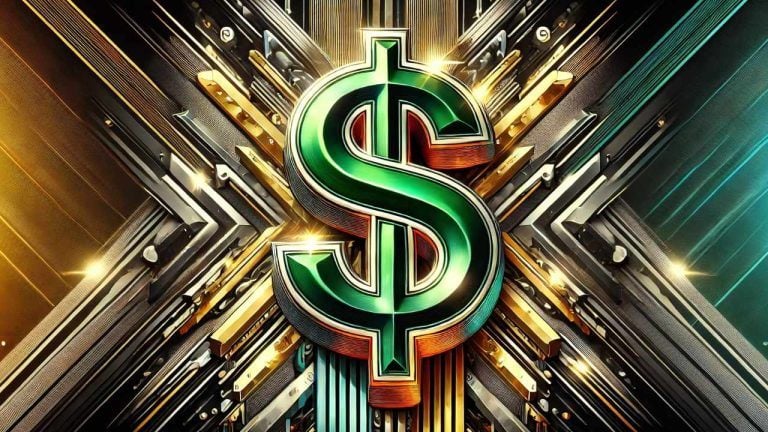 U.S. Senator Bill Hagerty has warned of growing efforts by BRICS nations to bypass the U.S. dollar’s dominance but argued this could ultimately strengthen the status of the dollar as the world’s reserve currency. He emphasized the need for a regulatory framework to boost demand for U.S. treasuries and stablecoins, while his stablecoin legislation aims […]
U.S. Senator Bill Hagerty has warned of growing efforts by BRICS nations to bypass the U.S. dollar’s dominance but argued this could ultimately strengthen the status of the dollar as the world’s reserve currency. He emphasized the need for a regulatory framework to boost demand for U.S. treasuries and stablecoins, while his stablecoin legislation aims […] In October 2024, the latest data shows that decentralized autonomous organizations (DAOs) hold $24.5 billion in treasuries, down by $12.6 billion since the end of March. Optimism’s DAO, which boasted $8.3 billion on Mar. 24, has seen its treasury shrink to $3.8 billion, making it the largest DAO treasury despite the decline. Decentralized Autonomous Organizations […]
In October 2024, the latest data shows that decentralized autonomous organizations (DAOs) hold $24.5 billion in treasuries, down by $12.6 billion since the end of March. Optimism’s DAO, which boasted $8.3 billion on Mar. 24, has seen its treasury shrink to $3.8 billion, making it the largest DAO treasury despite the decline. Decentralized Autonomous Organizations […] JPMorgan Chase sees the possibility of the Federal Reserve making another significant rate cut in November, possibly by 50 basis points. The bank, which predicted this week’s half-point cut, believes further reductions are likely if the job market weakens. While some other Wall Street firms have adjusted their outlooks, JPMorgan remains confident in its forecast, […]
JPMorgan Chase sees the possibility of the Federal Reserve making another significant rate cut in November, possibly by 50 basis points. The bank, which predicted this week’s half-point cut, believes further reductions are likely if the job market weakens. While some other Wall Street firms have adjusted their outlooks, JPMorgan remains confident in its forecast, […]
Investors are pouring capital into US and global bond funds in anticipation of rate cuts from the Federal Reserve. In the week ending August 28th, a total of $17.69 billion in global bond funds was purchased, with $9.58 billion allocated to US bond funds, reports Reuters, citing LSEG data. The numbers represent a six week […]
The post $9,580,000,000 Pours Into US Bond Funds As Global Markets Anticipate Imminent Federal Reserve Rate Cuts: Report appeared first on The Daily Hodl.

Cantor Fitzgerald has been managing Tether’s now $90 billion Treasury portfolio since late 2021.
Howard Lutnick, the CEO of Wall Street firm Cantor Fitzgerald has praised stablecoin issuer Tether (USDT), describing himself as a "big fan" of the firm.
"I'm a big fan of this stablecoin called Tether...I hold their treasuries. So I keep their treasuries, and they have a lot of treasuries,” Lutnick said in a Dec. 11 interview with CNBC.
“They're over $90 billion now, so I'm a big fan of Tether,” the Cantor Fitzgerald CEO said.

Bitcoin’s price has been showing weakness near the $30,000 level, but multiple data points highlight the fact that bears remain at a disadvantage.
Bitcoin’s price gave back some of its recent gains this week, but multiple data points suggest that $30,000 should hold as support going forward.
Bitcoin (BTC) remained within a narrow 4.3% range for the 15 days leading up to July 7. Despite the proximity of the $29,895 to $31,165 range, investors’ sentiment was significantly impacted by an unsuccessful attempt to break above $31,400 on July 6.
Traders’ tendency to overreact to short-term price movements rather than Bitcoin’s year-to-date gains of 82% could be part of the reason for the short-term correction. This same rationale applies to the events related to other cryptocurrencies.
At the forefront of investors’ minds are questions about whether the recent price gains were solely driven by multiple spot Bitcoin exchange-traded fund (ETF) requests.
Other pressing developments include Binance’s chief strategy officer, Patrick Hillmann, and other top compliance officers reportedly leaving the exchange on July 6 over CEO Changpeng Zhao’s response to the United States Justice Department’s investigation. On June 29, the crypto exchange also informed users that its euro banking payment gateway would cease services by September, potentially halting deposits and withdrawals via SEPA bank transfer.
Meanwhile, the yield curve on interest rates reached its deepest inversion since 1981 on July 3, reflecting the two-year note’s 4.94% yield compared to the 10-year note trading at 3.86%, the opposite of what is expected from longer-term bonds. The phenomenon is closely watched by investors, as it has preceded past recessions.
All of these events are likely having some impact on the Bitcoin price and investor sentiment. Both topics are explored in greater depth below.

The OKX margin lending indicator based on the stablecoin/BTC ratio has steadily increased from 20x favoring longs on July 1 to the current 29x ratio on July 7, indicating growing confidence among traders using margin lending. However, it remains within a neutral-to-bullish range, below the historical 30x threshold associated with excessive optimism.
Besides leaving room for further long leverage, the indicator shows no signs of potential stress on margin markets in case of a sudden Bitcoin price correction.
Traders can also gauge the market’s sentiment by measuring whether more activity is going through call (buy) options or put (sell) options. A 0.70 put-to-call ratio indicates that put option open interest lags the more bullish calls and is, therefore, bullish. In contrast, a 1.40 indicator favors put options, which can be deemed bearish.

The put-to-call ratio for Bitcoin options volume has remained below 1.0 for the past three days, suggesting a higher preference for neutral-to-bullish call options. The important thing here is, despite Bitcoin’s price briefly correcting to $29,750 on July 7, there was not a significant surge in demand for protective put options.
The top traders’ long-to-short net ratio excludes externalities that might have solely impacted the options markets. There are occasional methodological discrepancies between different exchanges, so readers should monitor changes instead of absolute figures.

The long-to-short ratio for OKX’s top traders increased from 0.52 on July 3 to 1.68 on July 7, indicating strong demand for leveraged long positions despite Bitcoin’s failure to break above $31,000. At Binance, the indicator declined from 1.52 on July 3 to 1.39 on July 7, remaining above its 1.33 average for the previous 30 days, which suggests a neutral reading.
Related: Bitcoin mining stocks outperform BTC in 2023, but on-chain data points to a potential stall
Natalie Brunell, an award-winning TV journalist, podcast host and educator in the Bitcoin space, spoke to Cointelegraph on how crypto is now being taken more seriously as an asset class by institutional investors, as evidenced by the multiple Bitcoin ETF filings, including by some of the world’s largest asset fund managers.
Speaking on Fox Business on July 5, Larry Fink, the CEO of BlackRock, also said that Bitcoin’s role was largely “digitizing gold," suggesting U.S. regulators consider how a spot ETF could democratize finance. Fink suggested that investors could turn to Bitcoin as a hedge against inflation or the devaluation of certain currencies.
So, from a bird’s-eye view, for those questioning whether Bitcoin is poised for a correction after a rally fueled by ETF hype, the resilience of traders’ bullish conviction and lack of excessive optimism observed in the BTC margin show they need to relax.
Bitcoin options and futures markets indicate that challenging times are ahead for Bitcoin bears and those expecting a sharp price correction solely due to regulatory and recessionary concerns.
This article is for general information purposes and is not intended to be and should not be taken as legal or investment advice. The views, thoughts, and opinions expressed here are the author’s alone and do not necessarily reflect or represent the views and opinions of Cointelegraph.
This article does not contain investment advice or recommendations. Every investment and trading move involves risk, and readers should conduct their own research when making a decision.

The Bitcoin futures' premium surge is having traders ask whether this is excitement or a return to the average after a multi-month bear market.
The Bitcoin (BTC) futures' premium has reached its highest level in 18 months on July 4. But traders are now questioning whether the derivatives metrics indicate "excessive excitement" or a "return to the mean" after a prolonged bear market.
Bitcoin's price has been trading in a narrow 4.4% range since June 22, oscillating between $29,900 and $31,160 as measured by its daily closing prices. The lack of a clear trend might be uncomfortable to some, but that is a reflection of the opposing drivers currently in play.
For instance, investor sentiment was negatively affected by the historic reversion of the U.S. Treasury yield curve, which reached its highest level on record.

The closely monitored inverted spread between the 2-year and 10-year Treasury notes has reached its highest level since 1981, standing at 1.09%. The phenomenon known as yield curve inversion, when shorter-dated Treasury notes trade at higher yields than longer-dated notes, typically precedes economic recessions.
Related: Fed pauses interest rates, but Bitcoin options data still points to BTC price downside
On the other hand, signs of strength in the U.S. economy have reportedly driven investors to price in the possibility of further interest rate increases by the central bank to keep inflation under control.
In addition to these macroeconomic distortions, cryptocurrency regulation has also been at the center of investors’ attention as of late. Here are just some recent examples:
So investors are probably now asking: Does Bitcoin have the strength to break above the $31,000 resistance? Of course, one must take a potential economic recession and the increasing regulatory clampdown measures around the world into account first.
Luckily, Bitcoin futures' contract premiums can provide some clues for traders about the market's next move for reasons discussed below — as well as the costs of hedging using BTC options.
Bitcoin quarterly futures are popular among whales and arbitrage desks. However, these fixed-month contracts typically trade at a slight premium to spot markets, indicating that sellers are asking for more money to delay settlement.
As a result, BTC futures contracts in healthy markets should trade at a 5% to 10% annualized premium — a situation known as contango, which is not unique to crypto markets.

The demand for leveraged BTC longs has significantly increased over the past week as the futures contract premium jumped to 6.4% on July 3 from 3.2% one week prior. Besides reaching the highest level in 18 months, the metric has finally moved to a neutral-to-bullish area.
Related: Here’s what happened in crypto today
To gaugue market sentiment further, it's also helpful to look at the options markets as the 25% delta skew can assess whether the price stagnation has made investors less optimistic. It reveals when arbitrage desks and market makers charge higher prices for protection against upside or downside movements.
In short, if traders expect a drop in Bitcoin's price, the skew metric will rise above 7%, while periods of excitement typically have a negative 7% skew.

The 25% delta skew metric experienced a complete turnaround, indicating bullish momentum picked up on June 21 when it dropped below -7%. As Bitcoin's price climbed back above $30,000, the indicator continued to improve, culminating in "greed" with a negative 13% skew on July 2.
Typically, a 6.4% futures basis and a negative 13% delta skew would be considered moderately bullish. However, considering analysts' estimating a 50% chance for BlackRock's spot Bitcoin approval, these metrics might be seen as conservative. But a certain amount of skepticism is indeed healthy for buyers using derivatives contracts and avoids the risk of cascading liquidations.
Related: Bitcoin ETF race begins: Has institutional trust returned to crypto?
Currently, macroeconomic factors and regulatory uncertainty likely explain the suppressed optimism for BTC derivatives despite multiple ETF requests from the world's largest asset managers.
So 18-month highs aside, the current Bitcoin futures' premium remains relatively modest, compared to previous instances of excessive optimism such as the 19% in October 2021.
Thus, today's 6.3% futures premium represents a healthy market as opposed to 10% or higher indicating excessive optimism or euphoria. Moreover, traders should remain confident given that bulls have room to further leverage long positions without running excessive risk.
This article does not contain investment advice or recommendations. Every investment and trading move involves risk, and readers should conduct their own research when making a decision.

The world’s second-largest stablecoin issuer wants to reduce its exposure to potential US debt defaults.
Stablecoin issuer Circle has reportedly adjusted its reserves treasury in an effort to reduce the risks of United States debt defaults.
According to a May 10 Politico newsletter, Circle CEO Jeremy Allaire said that the firm has adjusted the mix of reserves backing its USD Coin (USDC) by switching to short-dated U.S. Treasuries to avoid getting caught up in a potential US debt default.
He said that the firm no longer holds Treasuries maturing beyond early June because it wants to avoid debt exposure.
“We don’t want to carry exposure through a potential breach of the ability of the U.S. government to pay its debts.”
The Blackrock-managed Circle Reserve Fund shows that current holdings mature no later than May 31.

Earlier this week, Treasury Secretary Janet Yellen said the government will be forced into making “decisions” if Congress doesn’t raise the federal debt limit.
U.S. President Joe Biden and Republicans are conflicted over raising the $31.4 trillion borrowing limit. The $24 trillion Treasury market and global financial system would be rattled if the country defaulted on its debts.
Rival stablecoin issuer Tether claims a majority of its reserves are invested in Treasury Bills with an average maturity of fewer than 90 days.
The firm stated that it has been “working to take steps to reduce its reliance on pure bank deposits as a source of liquidity,” according to a May 10 quarterly assurance report.
Related: Concern over banking crisis reaches levels unseen since 2008 — Poll
USDC supply has been shrinking over the past year, falling by 46% since its all-time high of $56 billion in June 2022. This has caused its market share to fall to 23% with a circulation of $30 billion. The beneficiary has been rival Tether as its market dominance has increased to 62% with a circulation of $82 billion USDT.
In April, Allaire blamed America’s war on crypto and the impending banking crisis for its dwindling market capitalization.
Cointelegraph reached out to Circle for further details but had yet to hear back at the time of publication.
Magazine: Unstablecoins: Depegging, bank runs and other risks loom

Assets held in DAO treasuries have more than doubled since the beginning of 2023, according to DeepDAO.
Decentralized autonomous organization (DAO) treasuries are rapidly growing having just surpassed a major milestone, according to DeepDAO.
According to figures from the DAO data platform, on March 31, total assets for all decentralized autonomous organizations reached a record $25.1 billion.
The treasury is the total sum of assets the DAO may use at its own discretion. It excludes DAO-managed but unowned assets such as staking accounts and reward fees.
Around $22 billion of that total is liquid with around $3.5 billion set aside for vesting, according to DeepDAO.
Remarkably, assets in DAO treasuries have more than doubled since the beginning of 2023 which is no mean feat for a bear market.

Furthermore, the figure of $25.1 billion represents around 40% of the total value locked for all of DeFi as reported by DeFiLlama. This is currently $61.7 billion following a 39% increase since the beginning of this year.
DeepDAO is a discovery and analytics engine for the DAO ecosystem that lists and analyzes financial and governance data for the fast-growing sector. DeepDAO reports that there are 12,108 DAOs, 2,353 of which are analyzed by the platform.
Related: DAO gets legal recognition in the US as Utah DAO Act passes
A DeepDAO representative told Cointelegraph the big movers are layer 2 DAOs, with infrastructure now the leading category overtaking DeFi.
“Up till recently Uniswap and BitDao were biggest with over $2 billion each, now with the addition of Optimism, Arbitrum, Polygon we’ve got a whole pack of really big DAOs,” DeepDAO’s Daniel Bar said.
total value across all DAO treasuries surpassed $25B for first time ever pic.twitter.com/VcymWJOkOy
— Jacquelyn Melinek (@jacqmelinek) March 30, 2023
The Optimism Collective is the leader in terms of treasury funds with $5.5 billion giving it a market share of 22%. Optimism is the second most popular Ethereum layer-2 solutions provider after Arbitrum One, according to L2beat.
However, Arbitrum has a slightly lower DAO treasury with $4.4 billion giving it a share of 17.5%.
The remaining DAOs comprising the top five include BitDAO, Uniswap, and Polygon with treasuries of $2.6 billion, $2.5 billion, and $1.5 billion respectively.
DeepDAO also reports that the most active DAO over the past week has been PancakeSwap with 66 decisions. The total number of decisions made for all DAOs analyzed over the past month was 3,300, a fall from February’s 3,700 decisions.
Web3 Gamer: Shrapnel wows at GDC, Undead Blocks hot take, Second Trip

BTC margin and options markets are steady, even as investors run for cover as crypto and stock prices fall.
Bitcoin (BTC) traders saw continued downward pressure after the 5.5% decline in BTC price on March 7. Increased odds of further interest rate increases by the Federal Reserve and regulatory pressure in cryptocurrencies explain some of the movement.
Financial markets showed signs of stress as the inverted bond curve reached its highest level since the 1980s. Longer-term dated yields have stalled at 4%, while two-year treasury notes traded above 5% yield in March.
Since July, longer-dated treasury yields have failed to keep pace with the surging two-year benchmark, resulting in the inverted curve distortion that typically precedes economic downturns. According to Bloomberg, the indicator reached a full percentage point on March 7, the highest level since 1981, when Fed Chair Paul Volcker faced double-digit inflation.
This week, BlackRock, the world's largest asset manager, increased its forecast for U.S. federal funds to 6%. Rick Riede, chief investment officer of global fixed income at BlackRock, believes the Fed will keep interest rates high for "an extended period to slow the economy and get inflation down to near 2%."
According to a Wall Street Journal report, the Biden administration wants to apply the wash sale rule to crypto, which would put an end to a strategy in which a trader sells and then immediately buys digital assets for tax purposes.
Furthermore, the Public Company Accounting Oversight Board (PCAOB), an organization that keeps an eye on audits of public companies in the United States, recently put out a warning to investors about proof-of-reserves reports that auditing firms send out.
The organization, backed by the U.S. Securities and Exchange Commission (SEC), said that: “investors should note that PoR engagements are not audits and, consequently, the related reports do not provide any meaningful assurance.”
Let's look at derivatives metrics to better understand how professional traders are positioned in the current market conditions.
Margin markets provide insight into how professional traders are positioned because it allows investors to borrow cryptocurrency to leverage their positions.
For example, one can increase exposure by borrowing stablecoins and buying Bitcoin. Borrowers of Bitcoin, on the other hand, can only take short bets against the cryptocurrency.

The above chart shows that OKX traders' margin lending ratio dropped dramatically on March 9, moving away from a situation that previously favored leverage long positions. Given the general bullishness of crypto traders, the current margin lending ratio at 16 is relatively neutral.
On the other hand, a margin lending ratio above 40 is very rare, even though it has been the norm since Feb. 22. It is partially driven by a high borrowing cost for stablecoins of 25% per year. Following the recent anomaly, the margin market has returned to a neutral-to-bullish state.
Traders should also analyze options markets to understand whether the recent correction has caused investors to become more risk-averse. The 25% delta skew is a telling sign whenever arbitrage desks and market makers overcharge for upside or downside protection.
The indicator compares similar call (buy) and put (sell) options and will turn positive when fear is prevalent because the premium for protective put options is higher than the premium for risk call options.
In short, if traders anticipate a Bitcoin price drop, the skew metric will rise above 10% and generalized excitement has a negative 10% skew.
Related: US REPO task force names crypto as target in efforts involving $58B in sanctioned assets

Even though Bitcoin failed to break the $25,000 resistance on Feb. 21 and then experienced a 14% correction in 16 days, the 25% delta skew remained in the neutral zone for the past month. The current positive 3% skew indicates a balanced demand for bullish and bearish option instruments.
Derivatives data shows that professional traders are unwilling to go bearish, as evidenced by options traders' neutral risk assessment. Furthermore, the margin lending ratio indicates that the market is improving as some demand for bearish bets has emerged, but the structure remains neutral-to-bullish.
Given the enormous downward price pressure from a macroeconomic standpoint, as well as ongoing regulatory pressure in the United States, bulls should probably be content that Bitcoin derivatives have remained solid.
The views, thoughts and opinions expressed here are the authors’ alone and do not necessarily reflect or represent the views and opinions of Cointelegraph.
This article does not contain investment advice or recommendations. Every investment and trading move involves risk, and readers should conduct their own research when making a decision.